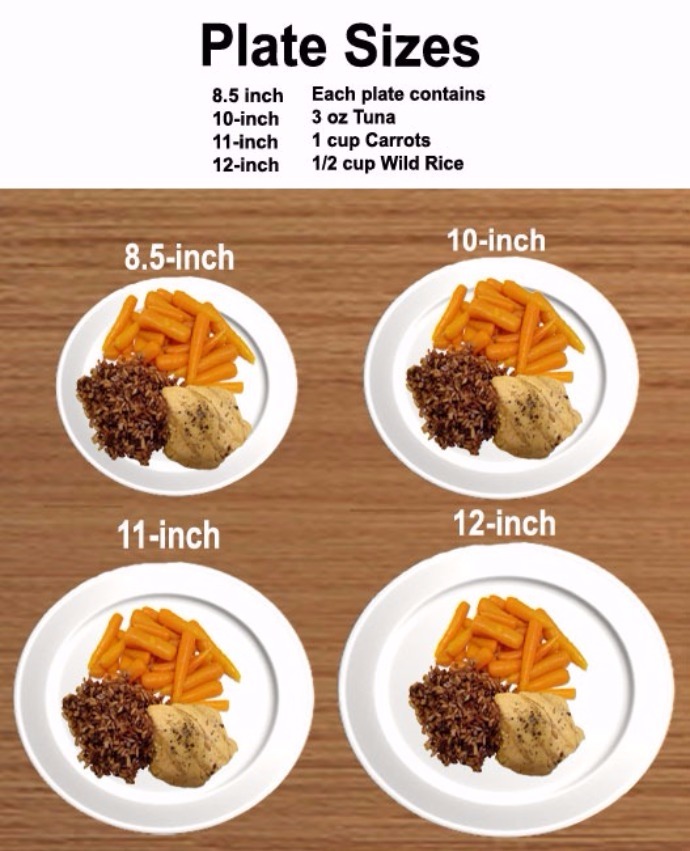Use the Delboeuf Illusion to influence elderly food consumption? If you are not familiar, the Delboeuf illusion is an optical illusion of relative size perception. The best-known image exemplifying this illusion is two circles of identical size placed near to each other. One is surrounded with another circle. The Delboeuf Illusion makes the one surrounded by a circle look larger than the other. It is not.

The Delboeuf illusion is visually robust with two-dimensional objects—the illu- sion is shown to exist for perfectly concentric circles but also for eccentric circles and, for instance, noncircular shapes such as squares, triangles, and rectangles (Weintraub and Cooper 1972; Weintraub and Schneck 1986). Jun 01, 2020 The Delboeuf illusion leads humans to overestimate food size in a small context.
The Delboeuf Illusion can influence elderly food consumption because vision plays a huge role in our perception of food. It influences how much we eat. Vision even affects our perception of how we think the food tastes.
Jan 18, 2012 An optical illusion documented by Belgian philosopher Franz Joseph Delboeuf in the 1860s could help to explain why smaller plates could help us battle the bulge, according to a new study. Jul 24, 2012 (This is a culinary twist on what's known as the Delboeuf Illusion.) To test the effect, two Cornell University researchers turned a college reunion into a research lab. Food Innovation Group. The Delboeuf illusion (often in connection with the Ebbinghaus illusion) has been used with great frequency in testing animal perception, since the ability to discern size seems highly relevant for many aspects of survival, particularly regarding food. The perception of the Delboeuf illusion differs greatly depending on the species.
A while back there were reports that using red plates for Alzheimer’s patients helped the elderly eat more food. Getting Alzheimer’s patients to eat more is a common struggle and many people ran out and purchased red plates. There were even companies selling red dinnerware and cups, specifically targeting caregiver’s of Alzheimer’s patients. Red plates did work much of the time, however a newer study demonstrated some faults in the concept. The newer study explored the Delbouef Illusion’s Bias on Serving and Eating Behavior.

We are influenced by more than plate color.
The researchers of the, “Plate Size and Color Suggestibility” study, did confirm that red plates could cause increased consumption of food,but only if there was a significant contrast with the food on the plate. Thus red plates were not always the best option to help the elderly to eat more. The study also discovered methods that will help people eat less. Basically their study revealed that the following methods would encourage people who struggle with vision issues or loss of interest in food to eat more:
- Use larger dinnerware to serve meals. Larger plates makes it seem like there is less food on the plate.
- Use dinnerware that contrasts greatly in color to the food (e.g. white food on red pates and red food on white plates)
- Use dinnerware that closely matches the color of the tablecloth.
Because of the Delbouf Illusion, how much one consumes is highly influenced not only by plate color, but also by plate size and even the background (tablecloth) the plate is placed upon.
Influence elderly food consumption by encouraging the elderly to eat more.
Getting the elderly to eat more is often an issue with Alzheimer’s patients and with the elderly who have health or vision issues. According to the American Family Physician organization, approximately one person in three has some form of vision-reducing eye disease by the age of 65. The most common causes of vision loss among the elderly are age-related macular degeneration, glaucoma, cataract and diabetic retinopathy. Vision issues can significantly reduce interest in food. If you struggle to see the food on the plate, you are less likely to eat it. Below are three methods to increase food consumption:
- Purchase a selection of both light and dark dinnerware and tablecloths that match the color of the dinnerware as closely as possible. By having the tablecloth and dinnerware match, it helps create the impression that the plate is larger by reducing its edges.
- Choose oversized dinnerware. Often square plates are larger than round plates, but all dinnerware varies in size. Dinner plates that are 14” in diameter are as available as 11” diameter plates. It is even possible to find 16” dinner plates. Also look for dinnerware that has as small a rim as possible. This will maximize the plating area.
- Coordinate your dinnerware to contrast with the food you are serving. This will make it as visible and appetizing as possible. Serve cottage cheese, Alfredo, and mashed potatoes on dark dinnerware. Serve salads, chili, and tomato soup using light or white dinnerware.
Employing these methods utilizes the Delboef Illusion to influence elderly food consumption. The illusion convinces the person consuming the meal that there is less food in front of them. Because the plate is larger and it fades into the same color tablecloth, the food portions will appear to be a smaller portion. The contrast between the food and dinnerware increases the visual appeal of the food being served, and it helps delineate the food from the plate. Whether your parent is a finicky eater or has vision difficulties, they will eat more of the food you serve them.
Influence elderly food consumption by encouraging the elderly to eat less.
Delboeuf Illusion Food

Often times the elderly find themselves in a sedentary lifestyle due to surgery or health issues. Others may have struggled with being overweight all their lives and are now faced with losing weight. Changing a lifetime of eating habits is difficult, but you can use the Delboef Illusion to help the elderly eat less. Below are three methods to decrease food consumption
- Purchase a selection of both light and dark dinnerware and the tablecloths that match in color as much as possible. By having the tablecloth and dinnerware match, it helps to create the impression that the plate is larger by reducing its edges.
- Choose undersized dinnerware that is 10 inch or 9 inch plates if you can. Select dinnerware with e a small rim over a large rimmed plate so the elder feels they have all plate “real estate” available to them.
- Coordinate your dinnerware to contrast with the food you are serving. This will make it as visible and appetizing as possible. Serve cottage cheese, Alfredo, and mashed potatoes on dark dinnerware. Serve salads, chili, and tomato soup using light or white dinnerware.
Employing these methods utilizes the Delboef Illusion to influence elderly food consumption. The illusion convinces the person consuming the meal that there is a full plate of food in front of them. The smaller plate will make servings appear larger and the similarity between the plate and the tablecloth will make the plate look larger. The contrast between the food and dinnerware increases the visual appeal of the food being served, and it helps delineate the food from the plate. Using this method will allow you to serve a person much less food but help them feel as if they have had a full meal. .

Other aspects of the study worth noting.
The study also showed there is a difference between being served and self-serving food. The researchers discovered, we have a strong tendency to over serve ourselves if we place food onto a plate that has little contrast to the food. It may seem a little confusing, but it all comes down to how visible the food is on a plate. In the process of self-serving you will put more greens onto a green plate than you will a white plate. And you put more Alfredo on a white plate than a red plate. A significant contrast between food and plate actually influences you to make the serving smaller. Same with a large versus a small plate. A large plate influences you to put more food on it than a small plate does. So when you are plating food for someone else, you’ll need to keep this in mind.
Keeping plate color and size, food contrast, and who is doing the serving clearly in mind before plating a meal can help you achieve concrete goals of increasing or decreasing food consumption. You can help the elderly eat more or less using the delboeuf illusion at each and every meal. You can even use it on yourself.
Delboeuf Illusion And Food Service
To read the study in its entirety, you can find it here:
Plate Size and Color Suggestibility: The Delboeuf Illusion’s Bias on Serving and Eating Behavior ,Koert Van Ittersum and Brian Wansink, Journal of Consumer Research, Vol. 39, No. 2 (August 2012) (pp. 215-228), Electronically published November 11, 2011